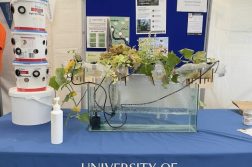The Wildlife Trusts have found that HS2, the high-speed train line which will connect London to the Midlands and up to Scotland, will have devastating ecological effects on some of our last remaining scraps of ancient habitat.
The planned low carbon transport network will destroy the very ecosystems which provides one of the natural solutions to our warming climate. The UK Wildlife Trusts, the National Trust, and the RSPB have called on the government to rethink the project and its cost to some of Britain’s most precious habitats and wildlife.
HS2 is branded as the solution for sustainable, low carbon transport in the UK. A journey on HS2 will emit seventeen times less carbon than the equivalent domestic flight and seven times less than the equivalent car journey. At first glance, it may seem the perfect answer to our ever-increasing carbon footprint, connecting 30 million people in 10 of the largest cities in the country. According to the HS2 website, it is ‘protecting and enhancing woodlands, habitats and wildlife’ by planting 7 million trees and shrubs along the Phase One (London to Birmingham) railway. This so-called Green Corridor aims to replace the habitats cleared for construction, while some species directly endangered by the project will be translocated. This may sound promising, however, basic ecological insights reveal major flaws.
A report by the Wildlife Trusts found that the number of wildlife sites affected by the train line is far from the ‘few’ outlined in the HS2 launch document. While HS2 found ‘no net loss of biodiversity’ along its tracks, wildlife organisations have pointed out that it will cut through habitats qualified by Natural England as irreplaceable. Amongst these habitats are 108 ancient woodlands, pastures, lakes and old meadows teeming with rare birds and bats. With only 308,000 hectares of ancient woodland left in Britain, clearing the last scraps sets a precedent for developers. We might find our land devoid of ancient trees and the species that depend on them before we know it. Not only are these habitats national treasures, but they are also protected by UK law—and in some cases, international law.
High Speed 2 Ltd with police taking over Calvert Jubilee nature reserve to begin clearance works today.
This project is being carried out in a way that destroys our natural environment. We ask the govt to stop and rethink. #HS2 #HighSpeed2 pic.twitter.com/UdRxlUxMgt
— BBO Wildlife Trust (@BBOWT) September 22, 2020
The Wildlife Trusts have warned that HS2 will bisect 33 Sites of Special Scientific Interest, 5 internationally protected wildlife sites, and no less than 693 local wildlife sites. It will also cut through 4 Nature Improvement Areas, the restoration for which the British public have paid £1.7 million. Furthermore, HS2 will create a physical barrier preventing the movement of birds, mammals and insects.
With this in mind, the promised Green Corridor hardly seems adequate to the scale of loss. Translocating endangered species to newly created habitats will not remedy the fragmentation of long-established ecosystems. The mere proposition underlines a critical lack of ecological understanding. With so few ancient wildlife areas still intact, it is crucial that we protect those that remain. Wildlife organisations are urging the government to retrace the path of HS2 to preserve veteran trees and rare habitats supporting the UK’s dwindling biodiversity.



